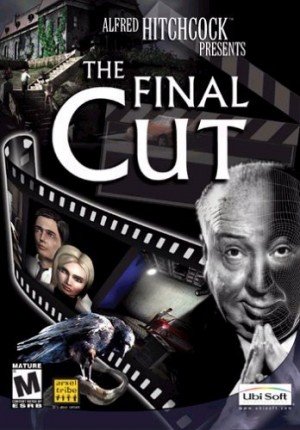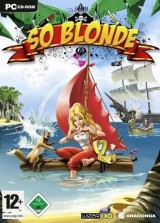Review for Hitchcock: The Final Cut
A short, stout man in full scuba gear sits perched on the edge of a diving board, dangling above a shark tank and says, “We’ll be back next week with another story of the bizarre and the mysterious. Till then…good night.” As a director, a screenwriter and a producer, this scuba diver made waves in the movie and TV industry, engaging audiences with his subtle camera techniques, daring mysteries and blatantly dark and often peculiar humor. Yet, Alfred Hitchcock is most frequently remembered for his opening and closing remarks on his popular television show entitled Alfred Hitchcock Presents. Now that the beloved Hitchcock is gone, Arxel Tribe and UbiSoft have worked to carry on the legacy in Alfred Hitchcock Presents: The Final Cut. I, like any fan of cult-status movies, normally embrace homages to daring filmmakers. The Final Cut, however, is better left on the shelf.
Had Hitchcock been alive to give closing comments on this final Alfred Hitchcock Presents mystery, he might have jumped headfirst into the tank, preferring instead to be devoured by sharks. As an adventure game, The Final Cut provides some atmosphere, some Hitchcock movie scenes and something like a story, but the sum of its parts equals one messy, confusing and muddled experience.
You play Joseph Shamley, a psychic detective with a dry sense of humor. You have been hired to investigate the deaths of several crew members filming a movie to honor the late Alfred Hitchcock. The premise sounds solid, and for the first few minutes after the unique opening sequence, you may feel involved in the story. But it doesn’t take long for you to realize the gap between this story and any creation from the late Hitchcock himself. Oftentimes, you will keep asking yourself, who was that dead body again? What was he doing up on the roof? Could anybody translate what he just said to me?
During one of the first moments in the game, I even found myself very confused by a jarring falsetto voiceover. I later discovered it to be the “voice” of a nearby crow. Yes, as a psychic, Joseph can also read the mind of a crow, and their psychic conversations are all utterly pointless. Can this possibly be in homage to Doctor Doolittle?
Along with the aforementioned gossipy crow, there are many names and lots of characters with relationships to various other characters that intertwine and baffle Joseph and the player as the story progresses. After a while, the player will not care to follow who is who and what is what in this dark and impersonal world. To be sure, a game that claims to be related to Hitchcock in any manner has at least one minor goal to achieve: create and establish a mysterious and engaging atmosphere. The story, however, is often so confusing and awkwardly developed that no gamer will feel captivated enough to even finish the game.
While the story is certainly revealed to be a disappointment, nothing is quite as out-of-place as the controllable main character, Detective Shamley. Joseph, our story’s detective and hero, encounters a number of dead bodies, and tends to alienate the players with his nonchalant reaction and treatment of chaos and dismembered bodies. Sure, Hitchcock could discuss in detail the most gruesome topics while dancing around in scuba gear, but his dark humor often fit the stories he created, while The Final Cut’s sense of humor seems unsophisticated, rushed, and out of context. As an example, Joseph Shamley runs across a literally brainless man in a bag, and, without giving away too much, cracks a very unfunny, pointless joke about the dead character. Though Alfred Hitchcock had been known for his oddball sense of humor, he would never allow it to overpower and destroy all human life present in his story, but the game does.
The Final Cut is so often filled with such non-sequiturs that it loses all credibility as a Hitchcock-worthy adventure. Had Arxel Tribe spent more time to develop characters with deeper and more thorough motivations, then the dark humor may have come more naturally, but, as is, I just shook my head and scrunched my face, baffled.
All is not lost, however, because at least five of the twenty dollars I spent went to some good cause. There is atmosphere, dark atmosphere in The Final Cut, established through the use of detailed 2D backdrops and your ability to snoop around in them with a 3D character, similar to contemporary games such as The Longest Journey and Syberia. I am truly entertained by my ability to be voyeuristic and this game, at the very least, attempts to provide players with a sense of mystery. The game drops you into a dark, atmospheric mansion and a rundown studio, where you can snoop around in various corners and peek into closets, pockets, under beds, and even inside potato bags.
After hours of aimless sniffing and peeking, however, the entertainment wears thin. With a cast of characters all worthy of being named the serial killer and a lead character who expresses no fear, sympathy, joy, anger or any real emotion, players are bound to lose motivation for uncovering the plot. The game’s only saving grace--and my only reason for continuing the horrendous detective work--was the atmosphere established through the minimalist environmental sound, brooding 2D backdrops, and sense of voyeurism.
Sure, the 2D backdrops look pretty and the ambient sound loops in a fittingly dismal manner, but the 3D character models appear flat, static, and sloppy-textured, as they mechanically traverse the spooky and realistic grounds. The only thing that fits the poor 3D character models is, in fact, the characters’ personalities, which are also flat, static and sloppily-written. Alfred Hitchcock did not work with cardboard cutout actors, and I would not expect a game baring Hitchcock’s name to develop a story filled with lifeless, paper-thin characters. This, however, is precisely the kind of story The Final Cut delivers. No matter how hard the game tries to recapture the spirit of Hitchcock by adding film footage and parallel plot points, in the end the game drowns in its own misery.
Hitchcock was and is known for his planning. He planned every camera angle, every actor’s and actress’s subtle nuance, every lighting shadow. Nothing was left to chance. Unfortunately, The Final Cut seems to have abandoned this philosophy of solid storytelling to pursue a more avant garde style, utilizing jerky camera cuts, irrelevant movie snippets, awkward and random lighting effects, and an odd mouse-keyboard interface. You move Joseph with the keyboard, complete actions with the spacebar, examine close-ups with the mouse and bring up a PDA system by right-clicking. Surely, the PDA notepad is a rather good idea since you will encounter many news articles and letters, but the end result is a mess of notes you rarely refer to while sleuthing around the movie set. Even though the PDA does little to help you complete your tasks during the game, the developers felt it was important enough to give it a life of its own, allowing it to appear on screen at will. For example, while opening doors, the PDA will pop up to tell you which key Joseph just used to unlock the door, blocking your view. I often had to click to remove the fat PDA from the screen before it disappeared on its own.
While the obtrusive PDA may be irritating at times, nothing is more likely to frustrate players than the messy and jolting camera shifts and even the camera non-shifts. Joseph will be strolling down the sidewalk, when all of a sudden the camera will jump behind a random building a block down the street. At times, the camera even gets stuck as Joseph skips along the sidewalk and far out of view, making me wonder what our sick-witted hero might be doing on his own, when no one’s watching. Hitchcock often enjoyed toying with the human imagination and fear of the unknown, but this game takes the mystery of the unknown too far. Adventure gamers want to know where they are guiding their characters, and the lack of this simple gameplay element in The Final Cut makes it a challenge to complete many simple tasks.
The challenges posed by poor gameplay and interface far surpass the challenges established in the puzzles and riddles. Since the majority of puzzle-solving involves finding keys and keycards and using them, players will not be required to do too much thinking, which, by the way, suits the mentality of the player-character and all of his suspects. The lack of difficult puzzles may even be a blessing, since you will frequently need all your patience and brainpower to figure out how to bring Joseph back into view of the camera so you can continue your investigation.
No amount of keyboard-clicking, mouse-scrolling, camera-jerking, puzzle-solving frustration could compare, however, to the technical difficulties I experienced about halfway through the game, where the characters would begin each dialogue string and then cut out into silence only to interject random comments here and there that did not even match the subtitles scrolling across the bottom of the screen. At first I thought Joseph’s psychic powers were, again, jumping into action; maybe the detective was picking up a radio transmission, or reading a character’s mind. Then I realized that I was missing pertinent information not because of Joseph’s psychic powers, but, rather, because of a glitch in the audio. Surely, I must admit that it was entertaining to watch characters sputter incoherent phrases at first, but, soon, the B-movie entertainment led to confusion and then aggravation. This is the kind of technical mishap Alfred Hitchcock would have prevented at all costs during the development of any of his mysteries. At least Hitchcock didn’t have to deal with the unpredictability of NPC’s.
Don’t get me wrong, I actually had a few moments of entertainment while literally jostling around in the Hitchcockian world in The Final Cut. I even found the voice acting for Joseph rather solid, although the scripting seemed to have come more from a Troma film than from a true masterwork by Hitchcock. The attractive backdrops and the initial premise work together to begin a game that seems to captivate the voyeur in me. But, in the end, the game’s use of the tag title Alfred Hitchcock Presents seems more a hollow ploy to lure in a specific audience, and I warn you not to buy into it with hopes of getting a quality detective story. To be honest, if you need a truly captivating and engaging mystery, I suggest searching out the Nancy Drew series. In Arxel Tribe’s The Final Cut, Alfred Hitchcock does not present; heck, he doesn’t even know The Final Cut exists, and I think it’s better that no one tells him about it.



_capsule_fog__medium.png)
























